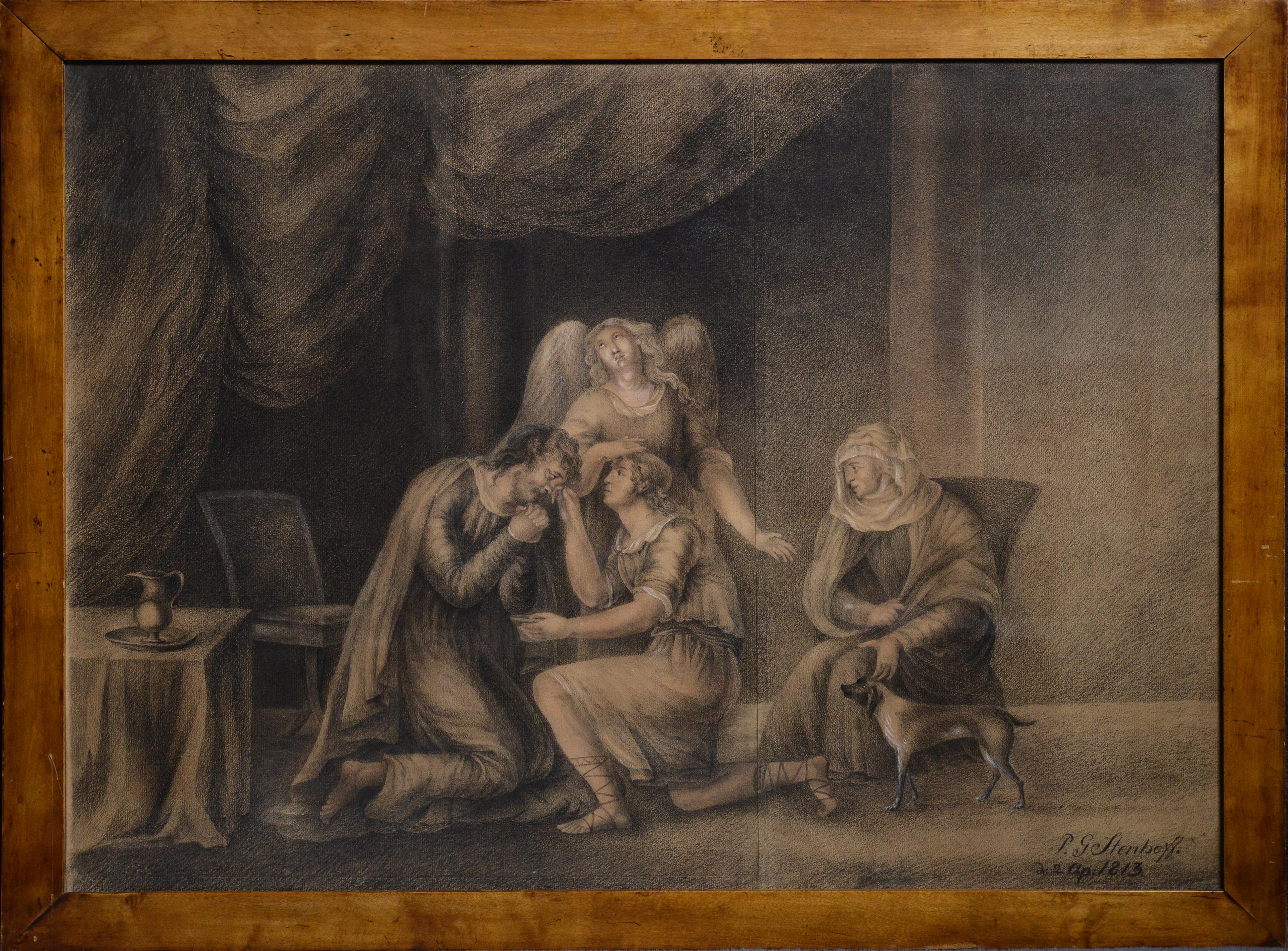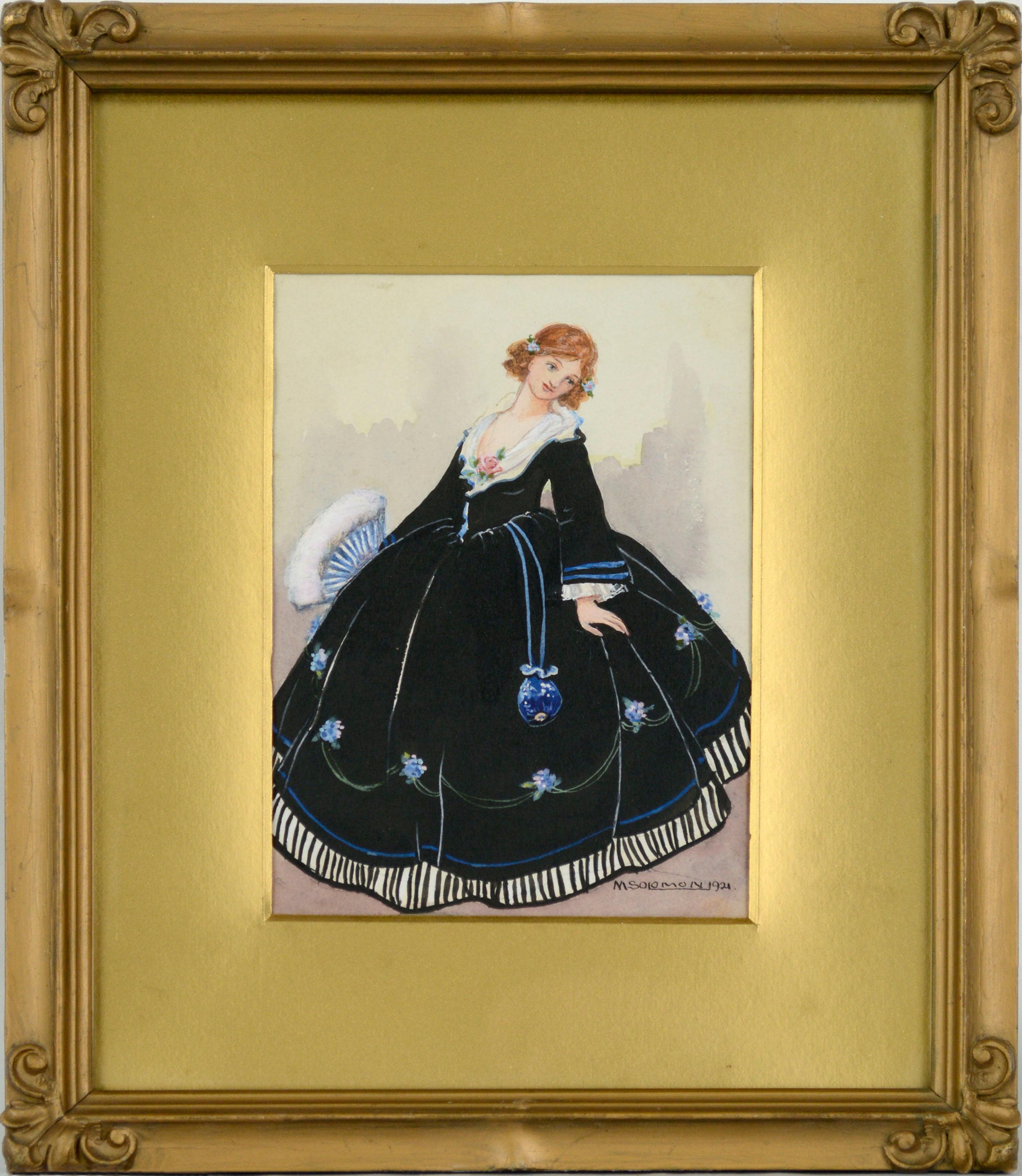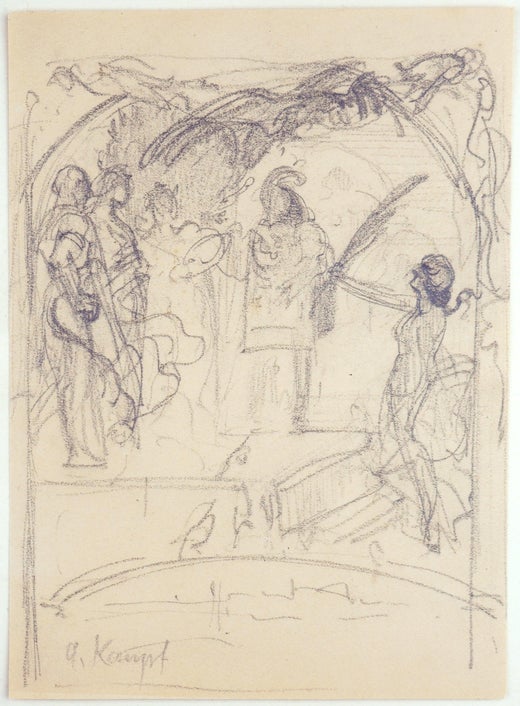Arthur KampfStudy for an allegory of victory / - A virtuoso victory -c. 1900
c. 1900
About the Item
- Creator:Arthur Kampf (1864 - 1950, German)
- Creation Year:c. 1900
- Dimensions:Height: 8.27 in (21 cm)Width: 7.09 in (18 cm)Depth: 0.4 in (1 cm)
- Medium:
- Movement & Style:
- Period:
- Condition:
- Gallery Location:Berlin, DE
- Reference Number:1stDibs: LU2438212631752
Arthur Kampf
Arthur Kampf was a German history painter, associated with the Düsseldorf school of painting, began study under Peter Janssen, at the Kunstakademie Düsseldorf from 1879–81. After completing his education, he began the professor career and also became a member of the Prussian Academy of Arts, and gave drawing lessons, notably to Prince August Wilhelm, son of Wilhelm II. In 1944, Kampf was one of 24 artists, architects, authors, composers, actors, and singers added to the Special list of the Gottbegnadeten list, meaning he was considered indispensable. Kampf's work is most strongly associated with the genre of traditional history painting though throughout his lifetime he explored styles influenced by Impressionism and Art Nouveau.

- ShippingRetrieving quote...Ships From: Berlin, Germany
- Return PolicyA return for this item may be initiated within 14 days of delivery.
- Evening Cottage Scene / - Somewhere in Nowhere -Located in Berlin, DEArthur Claude Strachan (1865 Edinburgh - 1954 Minehead), Evening Cottage Scene. Watercolor on paper, mounted, 28 x 46 cm (visible size), 48 x 65 cm (fra...Category
Early 1900s Realist Landscape Drawings and Watercolors
MaterialsPaper
- The Ruins of St. Clement's Church in Visby, Sweden / - Real romanticism -Located in Berlin, DEOtto Günther-Naumburg (1856-1941), The Ruins of St. Clement's Church in Visby, Sweden. Watercolor and ink, heightened with white, on sand-colored paper, mounted on cardboard, 33 x 24...Category
Early 20th Century Realist Landscape Drawings and Watercolors
MaterialsPaper
- Red blooming war landscape with dead soldier - Bleeding flowers -Located in Berlin, DEJohannes Friedrich Heinrich Hänsch (1875-1945), Red blooming war landscape with dead soldier, 1918. Watercolor and gouache on paper, 15 x 24.5 cm (image), 27 x 37 cm (sheet size / frame), monogrammed and dated "19JH18" at lower left. - Paper slightly darkened About the artwork Despite the relatively small format, the watercolor with an internal frame depicts a panoramic view of a flat landscape stretching to the horizon. As far as the eye can see, the poppies bloom in flaming red. The flowers are not rendered individually, however, creating an almost cohesive red surface. The bright red is interspersed with vegetal green. A complementary contrast that creates an intense color effect. In this color contrast, a white area breaks through from the middle ground, widening towards the foreground and surrounding a brown hole. Next to it, in blue, is the actual protagonist of the painting, the first thing that catches the eye: a dead soldier. Next to him is his helmet, revealing the empty interior. The brown, hollow shape corresponds to the hole in the ground. A shell funnel is surrounded by bright ash, which, like the inverted helmet, becomes a sign of death. The soldier's arms point to the funnel, while the empty helmet paraphrases the calotte of the skull and, like the funnel, thematizes the empty darkness of death. The soldier's body, however, is intact and not - as in Otto Dix's triptych "The War" - a dismembered corpse. Instead, Johannes Hänsch activates the landscape, especially the color, to illustrate a blooming landscape of death that extends from the shell funnel in the foreground to the rising column of smoke on the horizon. If the soldier's body is intact, the tangle of barbed wire emblematically placed over the empty helmet also appears tattered. On the right side of the picture, the barbed wire even seems to stretch its arms to the sky in horror. Against the background of this allegory, the content of the bright red also becomes clear: the landscape is drenched in blood, literally a sea of blood, and the single unknown soldier stands pars pro toto for all those who died on the battlefield. Dying in war is not dying in community, but in solitude. In order to emphasize the isolation in death, Johannes Hänsch has set the blue of the soldier in the axis given by his body in the middle ground of the picture into the red sea. A master of landscape painting, Hänsch succeeds in creating a natural-looking landscape allegory that illustrates the horror and death of war, without depicting the brutality of war itself. This singular 'war memorial' of the unknown soldier is the opposite of heroization and yet the dignity of the deceased soldier is preserved through the integrity of his body. About the artist As the son of the sculptor Adolf Haensch, the young Johannes received his first artistic training in his father's Berlin studio. However, he eventually decided to become a painter, and in 1897 he entered the Berlin Academy of Arts. He initially studied under Paul Vorgang and Eugen Bracht, and was particularly influenced by Bracht's increasingly colourful landscape painting. In 1901 he moved to the class of Friedrich Kallmorgen, with whom he spent several weeks on excursions into nature. In 1905 he became a master pupil of Albert Hertel, who taught him watercolour painting. From 1903 to 1933 he exhibited annually at the Great Berlin Art Exhibition, the exhibitions of the Berlin Artists' Association and the Munich Glaspalast. In 1905 he was awarded the Carl Blechen...Category
1910s Realist Figurative Drawings and Watercolors
MaterialsWatercolor
- Study with Torso, Hands, and Umbrella - The characteristic of the inconspicuousLocated in Berlin, DEPaul Friedrich Meyerheim (1842 Berlin - 1915 ibid.). Sketch of a female torso with hands and an umbrella. Pencil on paper, 27.5 x 22.5 cm (visible size)...Category
1890s Realist Figurative Drawings and Watercolors
MaterialsPencil
- Sketch of a head - Carved in stone -Located in Berlin, DEEmil Faesch (1865 Basel - 1915 Basel). Sketch of a head. Charcoal on painting cardboard, 60 x 47.5 cm (folio size), signed and dated at lower right "E. Faesch. 1888.". Minor browning. - Carved in stone - About the artwork The life-size head has an immensely present presence. This effect is due to the fact that Faesch took his cue from academic classical...Category
1880s Realist Figurative Drawings and Watercolors
MaterialsChalk
- Self-portrait - Homo nudus -Located in Berlin, DEBruno Paul (1874 Seifhennersdorf - 1968 Berlin). Self-portrait, c. 1895. Pencil on paper, mounted on cardboard, 53.5 x 35 cm, signed 'Paul' at upper left. - Homo nudus - About the artwork In a mirrored situation, Bruno Paul looks at himself in the picture. While his body, which is the size of the format, is shown in profile parallel to the picture, he turns his head into the picture in order to become aware of himself there, whereby the lighter use...Category
1890s Realist Figurative Drawings and Watercolors
MaterialsPencil
- Old Testament Scene with Angel 1813 Large Grisaille Drawing on Paper SignedLocated in Stockholm, SEOne of the characters in this scene is a mature man, kneeling with his head bowed and hands clasped near his chest in a gesture of supplication. His posture conveys a sense of humili...Category
Early 19th Century Realist Figurative Drawings and Watercolors
MaterialsMahogany, Paper, Watercolor, Pencil
- Polo Match, Cirencester, Player Leading Pony. Cotswolds. Framed Watercolor.By Elin Sian BlakeLocated in Sutton Poyntz, DorsetElin Siân Blake. Welsh ( b.1981). Polo Match, Cirencester, Player Leading Pony. Watercolor on paper. Signed lower right. Image size 11.2 inches x 15.4 inches ( 28.5cm x 39cm ). Fram...Category
21st Century and Contemporary Realist Animal Drawings and Watercolors
MaterialsPaper, Watercolor
- Stable Friends. Welsh Farmer. Turning Horses. Camaraderie Across GenerationsBy Elin Sian BlakeLocated in Sutton Poyntz, DorsetElin Siân Blake. Welsh ( b.1981). Stable Friends. Pastels on colored paper. Signed lower right. Image size 11.2 inches x 7.7 inches ( 28.5cm x 19.5cm ). Frame size 18.7 inches x 15....Category
21st Century and Contemporary Realist Figurative Drawings and Watercolors
MaterialsPaper, Pastel
- Polo Match, Cirencester, Player and Pony. Cotswolds. Parkland. Framed WatercolorBy Elin Sian BlakeLocated in Sutton Poyntz, DorsetElin Siân Blake. Welsh ( b.1981). Polo Match, Cirencester, Player and Pony. Watercolor on paper. Signed lower right. Image size 15.2 inches x 11.6 inches ( 38.5cm x 29.5cm ). Frame...Category
21st Century and Contemporary Realist Animal Drawings and Watercolors
MaterialsPaper, Watercolor
- Untitled (Man Reclining on Tile Floor)By Mark BeardLocated in New York, NYGraphite and conté crayon on paper Signed and dated, l.r. This artwork is offered by ClampArt, located in New York City. Mark Beard, born in 1956 in Salt Lake City, now lives in Ne...Category
1970s Realist Figurative Drawings and Watercolors
MaterialsPaper, Graphite, Conté
- 1920's Historical Fashion Illustration of Lady in 17th Century DressLocated in Soquel, CAFinely detailed historical figurative fashion illustration painted in watercolor in 1921, of a lady in 17th century dress; complete with a full blac...Category
1920s Realist Figurative Drawings and Watercolors
MaterialsPaper, Watercolor



